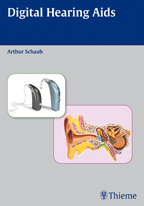Digital Hearing Aids is an essential reference for information about the latest innovations in digital hearing aid
technology. Concise descriptions and easy-to-reference tables and diagrams enable the reader to rapidly gain a solid
understanding of digital signal processing, including such important topics as adaptive acoustic directionality,
adaptive noise reduction, adaptive feedback cancellation, and sound classification. The book is divided into three main
sections, with the first section providing an overview of foundational concepts, the second section presenting detailed
analysis of state-of-the-art processing techniques, and the third section describing specific technical aspects of
digital processing.
Highlights:
Each chapter opens with a brief overview of topics and questions, rapidly orienting the reader with the scope of the
material presented
Mathematical examples in the third section of the book allow the reader to work through practical calculations,
comprehend the nuts and bolts of the processing schemes, and understand the benefits and limitations of each
More than 170 illustrations and diagrams aid the comprehension of key concepts
This handbook is ideal for audiologists, otolaryngologists, speech-language pathologists, and for other professionals
involved in the applications of digital signal processing.
TABLE OF CONTENTS
Foreword
Preface
Part I Basics and overview
1. Acoustic signals
2. Hearing impairment
3. Overview of hearing aid characteristics
4. Basic amplification schemes
Part II Signal processing in digital hearing aids
5. Static behavior of digital WDRC
6. Temporal behavior of digital WDRC
7. Acoustic directionality
8. Noise reduction
9. Feedback cancellation
10. Sound classification
Part III Calculations in the digital processor
11. Segment-wise processing with Fourier transforms
12. Digital filters
13. Digital level measurement
14. Autocorrelation and prediction
15. How everything fits together


